Benchmarked: Razer Blade Stealth versus 13-inch MacBook Pro with function keys
At $1,600, the 2019 13-inch Razer Blade Stealth represents an incredible value, boasting a 1.8GHz quad-core Intel Core i7 processor, 16GB of RAM, 256GB of storage and a powerful dedicated MX150 graphics card. See how it stacks up to a comparable MacBook Pro.

Beyond internals, the Blade Stealth tops most Windows laptops on the market in terms of build quality and design, with a unibody aluminum chassis, large trackpad, great keyboard and incredibly thin bezels around the 100-percent sRGB display.
Apple's 13-inch MacBook Pro without Touch Bar comes closest in terms of price at $1,500, but falls short on paper with a 2.3GHz dual-core Intel Core i5 processor, integrated graphics, 8GB of RAM and 256GB of storage.
We pitted the two machines against each other in a series of benchmark tests. Starting with Geekbench 4's CPU test, the Stealth achieved a single-core score that's only 8-percent better than the MacBook Pro, but in multi-core, the Stealth was much faster. The Razer managed a multi-core score of 16,017, some 67 percent above the MacBook Pro's score of 9,577.
The Stealth also topped the MacBook Pro in Cinebench R15's CPU test with relative scores of 665 and 375.
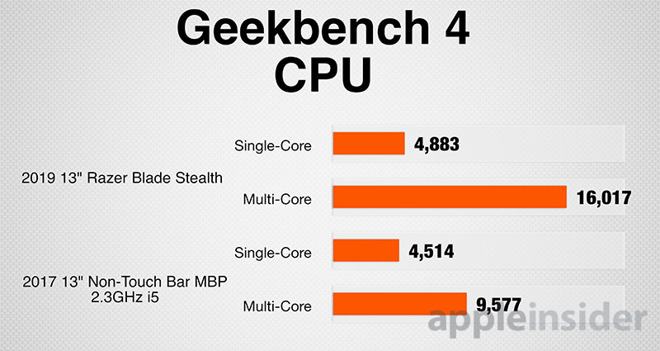
Moving on to graphics, the Stealth completely blew the MacBook Pro out of the water in Geekbench 4's OpenCL test, turning in a score of 47,516. That figure is 53 percent higher than the 31,075 score out of the Mac's integrated Intel Iris Plus 640 chip.
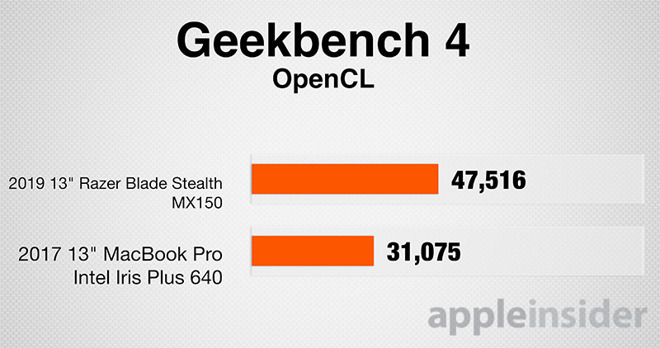
Turning to Cinebench R15's graphics test, which measures performance in terms of calculated frames per second, the Stealth again easily outperformed. Razer's laptop shot up to 86.64 fps compared to only 37.93 fps on the Mac.
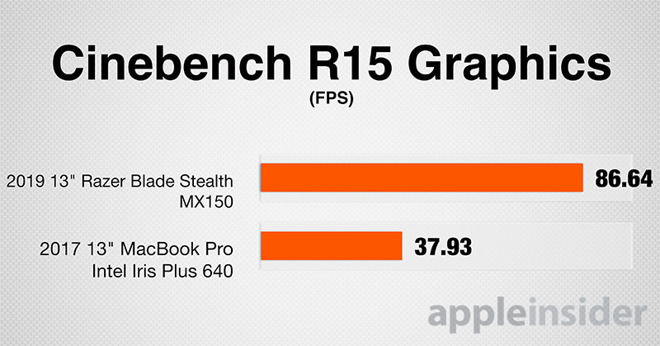
Finally, we ran Unigine's Heaven benchmark to see how well each laptop would perform under a gaming workload. The 13-inch MacBook Pro only scored 8.8 fps compared to 19.5 fps on the Blade Stealth, which is a massive difference. Keep in mind that games, and this benchmark, run better on Windows than they do on Mac due to software optimizations.
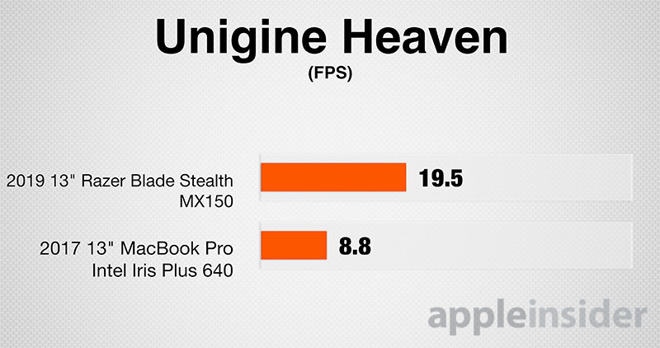
Based on the results, the 13-inch Razer Blade Stealth appears to offer incredible performance for a relatively low price point. It should do a pretty good job at gaming and even video editing, attributes made all the more surprising given its thin size.
Unfortunately, the 13-inch Non-Touch bar MacBook Pro lags behind both in performance and value.
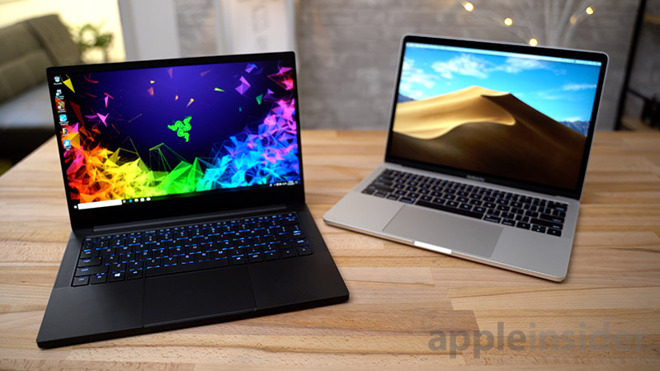
Apple's new 2018 13-inch MacBook Pro packs a quad-core processor that might keep up with the Razer, but at a base price of $1,799, you only get 8GB of RAM and integrated graphics. The specs of that model actually match up more closely to the base Blade Stealth, which also comes with 8GB of RAM, integrated graphics and 256GB of storage. That said, the cheapest Stealth runs $1,400, $400 cheaper than the quad-core 13-inch MacBook Pro.
Overall, the new 2019 13-inch Razer Blade Stealth is definitely a performer, offering the most bang for your buck when it comes to performance. That's not the only piece of the puzzle, however, as Mac users will note Apple laptops tout a superior design, are more reliable and come with a trouble-free operating system.

Beyond internals, the Blade Stealth tops most Windows laptops on the market in terms of build quality and design, with a unibody aluminum chassis, large trackpad, great keyboard and incredibly thin bezels around the 100-percent sRGB display.
Apple's 13-inch MacBook Pro without Touch Bar comes closest in terms of price at $1,500, but falls short on paper with a 2.3GHz dual-core Intel Core i5 processor, integrated graphics, 8GB of RAM and 256GB of storage.
We pitted the two machines against each other in a series of benchmark tests. Starting with Geekbench 4's CPU test, the Stealth achieved a single-core score that's only 8-percent better than the MacBook Pro, but in multi-core, the Stealth was much faster. The Razer managed a multi-core score of 16,017, some 67 percent above the MacBook Pro's score of 9,577.
The Stealth also topped the MacBook Pro in Cinebench R15's CPU test with relative scores of 665 and 375.

Moving on to graphics, the Stealth completely blew the MacBook Pro out of the water in Geekbench 4's OpenCL test, turning in a score of 47,516. That figure is 53 percent higher than the 31,075 score out of the Mac's integrated Intel Iris Plus 640 chip.

Turning to Cinebench R15's graphics test, which measures performance in terms of calculated frames per second, the Stealth again easily outperformed. Razer's laptop shot up to 86.64 fps compared to only 37.93 fps on the Mac.

Finally, we ran Unigine's Heaven benchmark to see how well each laptop would perform under a gaming workload. The 13-inch MacBook Pro only scored 8.8 fps compared to 19.5 fps on the Blade Stealth, which is a massive difference. Keep in mind that games, and this benchmark, run better on Windows than they do on Mac due to software optimizations.

Based on the results, the 13-inch Razer Blade Stealth appears to offer incredible performance for a relatively low price point. It should do a pretty good job at gaming and even video editing, attributes made all the more surprising given its thin size.
Unfortunately, the 13-inch Non-Touch bar MacBook Pro lags behind both in performance and value.

Apple's new 2018 13-inch MacBook Pro packs a quad-core processor that might keep up with the Razer, but at a base price of $1,799, you only get 8GB of RAM and integrated graphics. The specs of that model actually match up more closely to the base Blade Stealth, which also comes with 8GB of RAM, integrated graphics and 256GB of storage. That said, the cheapest Stealth runs $1,400, $400 cheaper than the quad-core 13-inch MacBook Pro.
Overall, the new 2019 13-inch Razer Blade Stealth is definitely a performer, offering the most bang for your buck when it comes to performance. That's not the only piece of the puzzle, however, as Mac users will note Apple laptops tout a superior design, are more reliable and come with a trouble-free operating system.


Comments
My own 13” 2017 MacBook Pro has already had to have the entire top section replaced due to the crummy keyboard design and it’s only 8 months old.
I really miss the reliability of my 2012 13” MacBook Pro.
They replaced the top section of my laptop because of a piece of dust. I genuinely thought the keyboard thing was really blown out of all proportion, which is why I bought it, but the issue is real.
Seriously, who designs a keyboard that can get taken out by a speck of bloody dust and then keeps that shoddy design on the market for years?!?!?!
For my brothers MacBook Pro the cost of repairs to fix the speaker issue would almost have paid for a brand new model, had he not been in warranty.
He is now concerned, and rightly so. The issues hardly bode well for the future and he spent £2600 on it as he upgraded a lot of the specs and had planned on keeping it for a number of years.
No computer is perfect, but this new generations issues seem largely due to the design being form over function. Apple’s obsession with their computers being thin has resulted in high failure rates and repairs that require to throw half the computer in the bin due to the way the parts are all soldered/glued together.
They know that for most people in the “Pro” category the bare minimum is 256GB SSD and 16GB Ram.
The only reason those models are there is to hit a headline price knowing that they will sell a lot more at £300 more to get the minimum specs that people need.
It's that bad, that I even now switched back to a 2015 model, accepting it's more heavy, slower and has shorter lasting battery. It's all better than the keyboard.
I might be unfortunate, but having to other friends with the same keyboard problem makes me question that I was just unlucky. I should also note, that my MacBook Air from 2011 and 2012 lasts both until today without any keyboard problem ever. 6 years without any problems vs a few months and stuck keys.
This focus on value what allowed Dell to surpass almost everyone in the PC business. They single handily killed off Gateway, and sent companies like IBM running for the hills (selling PCs).
When you buy a MacBook, the expectations is you get value from the quality of components and longevity of the machine. The reality for many is they’re better off buying a Windows machine now, with the full knowledge that they’ll probably need to replace it with another while the MacBook is still going strong.
When you buy a premium car is it worth it? What about a premium washing machine? All these comparisons are worth discussing. There is no universal right answer...
My biggest complaint about Apple is their pricing. I find value in the iPhone & iPad product lines, but I don’t own a Mac. As much as I dislike Windows 10, I don’t own a Mac. I’m not sure I’ll ever own a Mac... because of price/value.
The business case (enterprise) for MacBooks (as I see it) is stronger than for “personal” machines. We’re talking about the cost for IT support factored in. Personally, I can do everything myself so there is no cost saving.
Would I recommend a MacBook to others? Sure. In the right situation. I can see value in a computer noob taking a MacBook to college, where Apple Stores are located everywhere for support.
Or, to put it yet another way: Theoretically, you could buy a Mac and install Windows over top of MacOS and run it as Windows machine. But, would ANYBODY do that? No! That would be incredibly stupid! They buy it for the OS and Apple's ecosystem, not the hardware.
Perhaps a more fair hardware comparison would be to compare a Mac to a Windows machine that cost, say, 2/3's as much as the Mac? Say: a $1,000 Windows machine to a $1,500 Mac? Now, that might be a fair comparison.
Also, if anyone wants to play games then they may be dual booting their Mac. Knowing the spec gap, may make them question whether sticking with their current favourite OS is the right choice.
But the new MacBook family design traits remove a lot of those advantages. You no longer get a long term reliable machine, resale value will certainly take a hit as people understandably will be nervous of buying these machines out of warranty due to the many issues that they have. From keyboards to speakers, logic board failures to port issues, the problems of the generation are everywhere, and in large reported numbers.
I love Apple, I've been an avid apple user for 13 years since I bought my first Mac mini and fell in love with Mac OS X, but these new MacBooks have really shook my faith in Apple and their quality control. I'm not sure if I should sell my MacBook Pro now whilst it is in warranty and seek out a model from 2015 or not, or get the extended warranty and hold on until they release a new design that is actually fit for purpose.
https://www.macworld.co.uk/feature/mac/macbook-pro-keyboard-problems-3653458/
For me, the points worthy of note are seeing FCPX on a 15” MacBook Pro outperform Premiere Pro on a 15” Dell XPS. We’re sliding back to 80s marketing tactics of comparing specs whilst ignoring platform-specific benefits and actual outcomes.
That said, I really wish they’d added their own GPU to the T2/T3 even the current A12X GPU matches the MX150/GTX1030.
It’s a very common design in Windows laptops though. I see that 1 to 1.5 inch of bezel or margin on the bottom of virtually on all 16:9 13” class laptops. Just use a 16:10 or 3:2 display.
i wouldn’t buy either machine. For Apple laptops, it’s T2 or bust. No idea why Apple is keeping the MBP13FN, or why they didn’t offer a 4-core version in the MBA13. And the Razer with an MX150 seems not powerful enough for gaming on the go, which is the purported raison d’etre for a Razer device. Also, you really shouldn’t be buying a Mac if you want to play games as the primary purpose of the device.
The first gen retina MBP that I got in 2012 worked perfectly for 4 years. Eventually the battery wore out and I replaced it for $299. Apple changed out the keyboard and top surface with the battery. They also replaced the screen for free which had elimination issues. The key for me was that the machine was as fast after 4 years as when I bought it. After the repair, I upgraded the SSD to 512GB and replaced my aging Mac mini as the house media server.